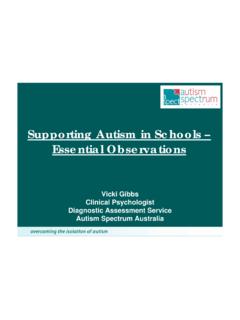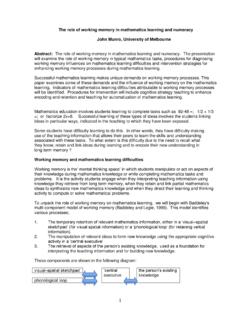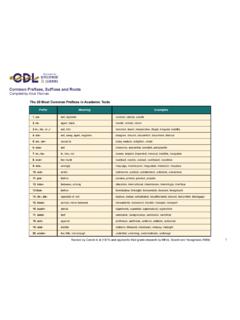Transcription of Impact, Recognition & Management Strategies - …
1 Anxiety and EducationImpact, Recognition & Management StrategiesDr Amanda GambleCentre for Emotional Health (formerly MUARU)Macquarie University, SHOULD I BE CONCERNED?1 Prevalence of Anxiety Prevalence rates Anxiety3 -5% - - - Test Anxiety occurs in ~33% of students2 Anxiety & Other Problems 30% of children with ADHD also have an anxiety disorder 25% of adolescents with reading problems have an anxiety disorder (most commonly social phobia) 50-85% of children with HFA/Asperger s have an anxiety disorder Anxiety exacerbates the severity of social and academic impairment Addressing the anxiety can drastically improve day to day functioning even when the main problem persists3 impact of Anxiety Anxiety disordered students Obvious distress and disability Less likely to have satisfying social relationships Higher ongoing usage of health facilities Take longer to move out of home Live a life (in their own words)
2 Of missed opportunity Early anxiety disorders predict adult anxiety disorders, depression, suicide, substance abuse and conduct problems 85% of depressed adolescents have a history of childhood anxiety growing out of it is a myth4 impact of Anxiety Anxiety disorders in children are high cost Estimate of $36 million cost per year to society Cost includes lost productivity in family as well as direct impact on child and health care5 Academic impact of Anxiety Anxiety leads to poor academic performance & under-achievement High anxious children in grade 1 are 10x more likely to be in bottom 1/3 of class by grade 5 High anxious students score lower than peers on measures of IQ and achievement tests (eg basic)
3 Skills) Anxiety leads to poor engagement in class High anxious students often avoid tasks that require communication or that involve potential peer or teacher evaluation They consequently miss the benefit of interactive learning experiences6 Anxiety leads to school refusal Anxiety leads to drop out 49% of anxious adults report having left education early, 24% indicated anxiety as the primary reason Academic consequences lead to long term economic losses for individual and society7 How does anxiety impact at school? Learning Attention Interpretation Concentration Memory Social Interaction Beliefs/Expectations Health8 Anxiety & Attention Attention is biased toward threat.
4 Anxious children are faster to orientate toward threatening stimuli. Scan the environment for possible sources of threat and process them in-depth (at expense of other environmental stimuli). 9A on the cross when it +Where did you look?Attentional Bias StudiesIn eye movement studies, anxious children: rapidly orientate eyes toward threat (early attention) Keep their eyes on the threatening stimulus and ignore neutral or positive information (sustained attention). Eye movements: anxious childEye movements: control childAnxiety & Interpretation Anxious students interpret neutral situations as threatening or dangerous Example: At the start of class the teacher says Tommy can you see me after class please.
5 Anxious automatic thought = I m in trouble Non-anxious auto thought = I hope I don t miss lunch Which is better for learning?18 Anxiety & Concentration Worry takes up mental capacity needed for other tasks As depth and breadth of worry increases, capacity to concentrate on academic tasks and solve problems decreases Anxious thoughts are intrusive Hiccup like thoughts, suppressing worried thoughts is incredibly difficult White bear effect19 Anxiety & Memory Anxiety associated with Decreased short term memory capacity General memory deficits Poor recall of previously mastered materials Possible reasons The same area of the brain (medial temporal lobe)
6 Plays a role in memory and anxiety therefore possibly reflects a dysfunction in these brain structures/processes Initial encoding is undermined by poor attention20 Anxiety & Social Interaction The cognitive biases also influence social interactions focus on potential threat at the expense of social cues react to neutral cues as if threatened Therefore they act less socially competent & avoid peer interactions/performance situations that involve potential threat to reduce anxiety Peers can identify anxiety in others and report liking these children less21 Anxiety & Beliefs/Expectations High standards and perfectionisticbeliefs lead to unrealistic expectations of performance Inability to live up to these expectations creates distress Self comparisons are relative to peer group Gifted students in gifted classes report increased anxiety and decreased academic self concept22 Anxiety & Health Anxiety symptoms include various physical complaints (sleep disturbance, fatigue, nausea, headaches, unexplained illness) These are real symptoms anxious children have a higher resting heart rate, higher blood pressure, higher skin conductance (tension) & higher free cortisol (stress hormone)
7 As symptoms are real there is an increase in missed school days reducing learning opportunities23 Consequences24 IDENTIFYING ANXIOUS CHILDREN?25 Nature of Anxiety Anxiety Disorders exist There is a fear or worry about a particular event or multiple areas of life Fear is excessive compared to peers or age-inappropriate The fear/worry causes significant distress and/or significant interference (often avoidance) in daily activities26 Types of DisordersSeparation Anxiety Disorder Fear separation from parents or other family Avoid being without parents or alone Excessive worry about possible separation Physical symptoms on separation27 Social Phobia Intense fear of being embarrassed or judged Avoid evaluation (speeches, conversation, class participating, library).
8 May lead to a limited number of friends or poor social skills Particularly at risk for school refusal and early drop out. 28 Generalized Anxiety Excessive worry about everyday life Worry is difficult to control Seek out reassurance constantly Uncanny ability to identify negatives in a situation Worry accompanied by stomach or head aches, irritability, poor concentration or fatigue29 Specific Phobia Paralyzing fear of an event, situation or object Avoidance and distress caused when confronted Common fears: dark animals, storms, heights, blood/injection/injury, vomiting & small spaces30 Obsessive Compulsive Disorder Recurrent, persistent and intrusive thoughts Repetitive behaviours aimed at reducing or preventing a dreaded event eg washing hands, counting, symmetry Panic Disorder with/out Agoraphobia Regular panic attacks for no apparent reason Worry that an attack will happen again Avoidance of places or activities for fear of having a panic attack Post Traumatic Stress Disorder Follows a life threatening event Re-experience event, avoid reminders.
9 Hyper-vigilant to threat31 School Phobia/ School Refusal Is not a diagnosis on its own but a symptom of other disorders Need to identify reason for avoiding school Most common possibilities include Fear of separation from parents* Fear of the social situations at school* Dysfunctional patterns of family behaviour Behaviour Management problems32 Signs of anxiety at School Reassurance seeking Overly well behaved/Bossy Mistakes, routine changes & new situations cause distress Physical symptoms (frequent) stomachaches, headaches Perfectionism Procrastination last minute or Limited friendships or age-inappropriate peer group Poor participation in class or playground Poor body language or vocal expression in groups/with authority figures Obvious anxiety during performance tasks Avoidance of specific classes ( , PE) Absence on special days (speeches, tests)
10 Or excursions Negative expectations of self, others & future34 Normal vs Clinical Anxiety Normal fears change from infancy to adolescence Normal fears differ from clinical anxiety in severity not quality Guiding principles Is the anxiety causing marked distress and/or interference in major areas of functioning? social life Is the behaviour and distress excessive comparedto other children their age?35 HOW CAN I APPROACH ANXIETY TO ENCOURAGE POSITIVE management361. Provide support and encouragement Open up a dialogue about anxiety Ask the child/adolescent if they worry about particular tasks when you have noticed they appeared anxious during those tasks.







